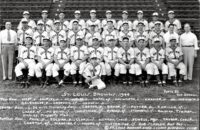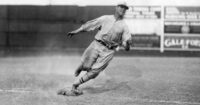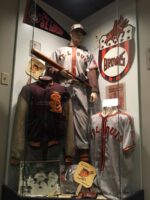Inductees
St. Louis Browns Baseball Club

The story goes that, after the inaugural 1901 season of the American League, founder Ban Johnson was convinced the circuit could compete in the same major cities as the National League.
However, the AL had one issue: Its last-place Milwaukee club needed to be rescued.
Thus was born the St. Louis Browns.
Relocated thanks to financial wizard Ralph T. Orthwein, the Browns called St. Louis home for the next 52 seasons, a stretch where they sadly became known as the “Lovable Losers” for their penchant for rarely being a first-division club, a pennant contender, in a city dominated by the NL’s Cardinals.
Still, the Browns are very much a part of Missouri’s historical fabric, and it’s why the Missouri Sports Hall of Fame proudly inducted the St. Louis Browns Baseball Club with the Class of 2018.
In fact, the Browns’ induction comes on the heels of the club’s revival of sorts.
The 2017 coffee-table book “St. Louis Browns: The Story of a Beloved Team” reached a No. 1 ranking on the Top 50 list in Sports Collectors Digest and may soon be on display in Cooperstown at the National Baseball Hall of Fame.
Plus, a documentary film – The St. Louis Browns: The Team That Baseball Forgot – recently set a record for local pledges and viewers on St. Louis’ PBS station. It followed the Ken Burns template and was narrated by actor and St. Louis native Jon Hamm, star of the “Mad Men” TV series.
The efforts have been spearheaded by the St. Louis Browns Historical Society, which bussed about a dozen former Browns to the MSHOF induction. The book was authored by Bill Borst, Bill Rogers and Ed Wheatley, with Wheatley steering the documentary film.
“Everywhere I go, they say, ‘This was my father’s team,’” said Wheatley, a board member of the St. Louis Browns Historical Society. “And there are other people who say, ‘My father has Alzheimer’s and we haven’t had a conversation in three years but, when I pulled out the book, he starts to talk about every one of the players. And there is a twinkle in his eye.’”
The Browns certainly held a special place to many, even for their struggles. After all, their narrative was as wild as a fly-by-night carnival roller coaster ride full of ups and downs and stops and starts.
It was the Browns ownership who built Sportsman’s Park and eventually added its upper deck. Overall, it was an iconic structure remembered fondly in oil paintings and old photos of the club’s other tenant, the St. Louis Cardinals.
Additionally, the 1944 Browns won the AL pennant, although it lost the World Series to none other than the Cardinals.
The franchise also featured George Sisler, a Hall of Famer who won two batting titles (in 1920 and 1922) and whose 257 hits in the 1920 season stood as the Major League Baseball record until Ichiro Suzuki broke it in 2004.
Sisler was one of two batting champions for the Browns – the other was George Stone in 1906 – and the franchise’s best stretch was between 1920 and 1928, when they finished in the upper half of the eight-team league some seven times. Along the way, pitcher Urban Shocker was a 20-game winner four consecutive seasons (1920-1923).
Unfortunately, by the time the Browns pulled up stakes and headed to Baltimore in 1953, few in the game took them seriously.
Two years earlier, then-owner Bill Veek – a showman whose circus-like stunts would be befitting of the minor leagues decades later – employed a 3-foot, 7-inch midget, Eddie Gaedel, to make an official plate appearance in a big-league game.
Worse, the Browns were a first-division club only 12 times in their history, with 1945 the last season they did so.
At the end of their final game in history, the Browns owned a meek .443 winning percentage, having suffered 4,465 losses and earned 3,414 wins.
All of which is captured in the book “St. Louis Brows: The Story of a Beloved Team” that features 700 photos and 300 vignettes.
“Just like a Civil War roundtable, we can still live the memory of the Browns because they have a rich history,” Wheatley said. “Because something is not really known doesn’t mean the story shouldn’t be told. That’s what we’re doing. And now that it’s being told, people are falling in love with it.”






